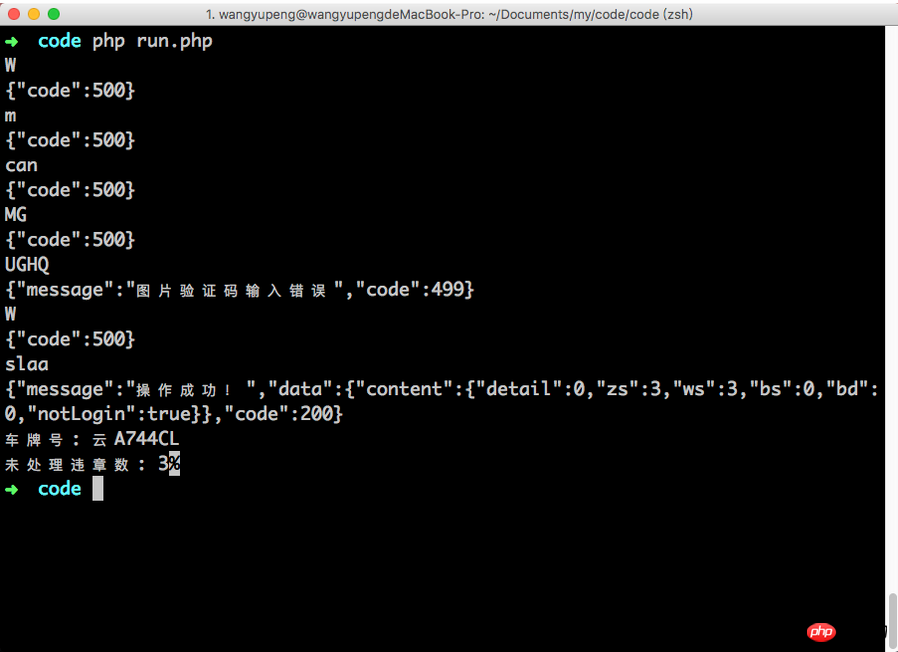Heim >Backend-Entwicklung >PHP-Tutorial >Detaillierte Erläuterung des PHP-Skripts zur automatischen Identifizierung von Verifizierungscodes und Abfrage von Fahrzeugverstößen
Detaillierte Erläuterung des PHP-Skripts zur automatischen Identifizierung von Verifizierungscodes und Abfrage von Fahrzeugverstößen
- 墨辰丷Original
- 2018-05-29 14:37:351269Durchsuche
Ich überprüfe oft, ob bei meinem Auto Verstöße vorliegen. Deshalb habe ich dieses Skript geschrieben, um zu überprüfen, ob bei meinem Auto Verstöße vorliegen. Wird hauptsächlich zur Simulation der Formularübermittlung und der Erkennung von Bestätigungscodes mithilfe von Cookies verwendet. Lassen Sie uns in diesem Artikel lernen, wie man das spezifische Skript schreibt.
Ich überprüfe oft, ob bei meinem Auto Verstöße vorliegen. Deshalb habe ich dieses Skript geschrieben, um zu überprüfen, ob bei meinem Auto Verstöße vorliegen.
Wird hauptsächlich zur Simulation der Formularübermittlung und der Erkennung von Bestätigungscodes mit Cookies verwendet.
Tesseract-OCR
Verifizierungscode-Erkennungstechnologie, Tesseract-OCR: https://github.com/tesseract-ocr/tesseract
Installation Tutorial: https://github.com/tesseract-ocr/tesseract
Tesseract-Ocr-For-PHP
Kapseln Sie die Befehle, die ausgeführt werden müssen
https://github.com/thiagoalessio/tesseract-ocr-for-php
Laden Sie das Skript direkt ohne Optimierung, werfen Sie einfach einen kurzen Blick darauf:
PHP
<?php
require 'TesseractOCR.php';
function weizhang($car_code, $fdjh)
{
$shanghui = mb_substr($car_code, 0, 1, 'utf-8');
$pre = array(
'冀' => 'he',
'云' => 'yn'
);
$url_pre = $pre[$shanghui];
$headers = array(
'Host: '.$url_pre.'.122.gov.cn',
'Origin: http://'.$url_pre.'.122.gov.cn',
'Referer: http://'.$url_pre.'.122.gov.cn/views/inquiry.html?q=j',
'User-Agent: Mozilla/5.0 (Macintosh; Intel Mac OS X 10_12_1) AppleWebKit/537.36 (KHTML, like Gecko) Chrome/50.0.2661.75 Safari/537.36 QQBrowser/4.1.4132.400'
);
//初始化变量
$cookie_file = 'cookie.txt';
$login_url = "http://$url_pre.122.gov.cn/views/inquiry.html?q=j";
$post_url = "http://$url_pre.122.gov.cn/m/publicquery/vio";
$verify_code_url = "http://$url_pre.122.gov.cn/captcha?nocache=".time();
$curl = curl_init();
$timeout = 5;
curl_setopt($curl, CURLOPT_URL, $login_url);
curl_setopt($curl, CURLOPT_RETURNTRANSFER, 1);
curl_setopt($curl, CURLOPT_HTTPHEADER, $headers);
curl_setopt($curl, CURLOPT_CONNECTTIMEOUT, $timeout);
curl_setopt($curl, CURLOPT_COOKIEJAR, $cookie_file); //获取COOKIE并存储
$contents = curl_exec($curl);
curl_close($curl);
$curl = curl_init();
curl_setopt($curl, CURLOPT_URL, $verify_code_url);
curl_setopt($curl, CURLOPT_COOKIEFILE, $cookie_file);
curl_setopt($curl, CURLOPT_HTTPHEADER, $headers);
curl_setopt($curl, CURLOPT_RETURNTRANSFER, 1);
$img = curl_exec($curl);
curl_close($curl);
$fp = fopen("verifyCode.jpg", "w");
fwrite($fp, $img);
fclose($fp);
$code = (new TesseractOCR('verifyCode.jpg'))->psm(7)->run();
$code = explode("\n", $code);
$code = $code[1];
echo $code.PHP_EOL;
if (strlen($code) != 4) {
return json_encode(array('code'=>500));
}
$data = array(
'hpzl'=>'02',
'hphm1b' => substr($car_code, -6),
'hphm' => $car_code,
'fdjh' => $fdjh,
'captcha' => $code,
'qm' => 'wf',
'page' => 1
);
$curl = curl_init();
curl_setopt($curl, CURLOPT_URL, $post_url);
curl_setopt($curl, CURLOPT_RETURNTRANSFER, 1);
curl_setopt($curl, CURLOPT_POSTFIELDS, $data);
curl_setopt($curl, CURLOPT_HTTPHEADER, $headers);
curl_setopt($curl, CURLOPT_COOKIEFILE, $cookie_file);
$result = curl_exec($curl);
curl_close($curl);
//unlink($cookie_file);
//unlink('verifyCode.jpg');
return $result;
}
$count = 0;
// 车牌号
$car_code = '冀Dxxxxx';
// 发动机后6位
$fdjh = 'xxxxxx';
while (true) {
$count++;
if ($count>50) {
exit('查询失败');
}
$res = weizhang($car_code, $fdjh);
$info = json_decode($res, true);
echo $res.PHP_EOL;
if ($info['code'] == 200) {
echo '车牌号: '. $car_code.PHP_EOL;
echo '未处理违章数: '.$info['data']['content']['zs'];
exit();
}
}Ausführungseffekt

Das Obige ist der gesamte Inhalt dieses Artikels. Ich hoffe, dass er für das Studium aller hilfreich sein wird.
Verwandte Empfehlungen:
CSS zur Erzielung eines Mausauslösereffekts
Das obige ist der detaillierte Inhalt vonDetaillierte Erläuterung des PHP-Skripts zur automatischen Identifizierung von Verifizierungscodes und Abfrage von Fahrzeugverstößen. Für weitere Informationen folgen Sie bitte anderen verwandten Artikeln auf der PHP chinesischen Website!
In Verbindung stehende Artikel
Mehr sehen- So verwenden Sie cURL zum Implementieren von Get- und Post-Anfragen in PHP
- So verwenden Sie cURL zum Implementieren von Get- und Post-Anfragen in PHP
- So verwenden Sie cURL zum Implementieren von Get- und Post-Anfragen in PHP
- So verwenden Sie cURL zum Implementieren von Get- und Post-Anfragen in PHP
- Alle Ausdruckssymbole in regulären Ausdrücken (Zusammenfassung)

